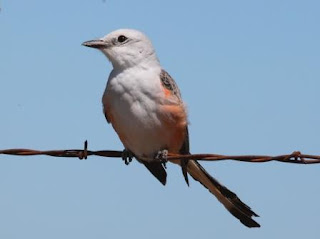Here is a pic of the Black-tailed Gnatcatcher. Not a a great shot, but this is a hard species to photograph in south Texas!

The only low point in the trip was arriving at the entrance road to 75 acre pond in Choke Canyon State Park. There was a barrier being put up by two female park rangers. I asked if we could get to the pond (where a Northern Jacana had been for several months) and was told abruptly NO. I asked where we could park to walk down the road and they said we couldn't even walk on the road! When I told them we had driven a long way just to look for the Jacana they said go look elsewhere in the park. The reason for the closure was the parking lot was flooded! The two staff members left a sour taste in our mouths about the state parks. All too often these government staff completely forget that they are supposed to be public servants!
On our final morning we drove back to San Antonio from Three Rivers. It is only about an hour and a half drive but we had fun counting Scissor-tailed Flycatchers. The tally was a remarkable 111 for the drive. At this time of year it is not unusual to see hundreds on a daily basis. Nonetheless one never tires of this gorgeous bird.

Also seen were a male Blue Grosbeak, 16 Crested Caracaras, and incredibly an Audubon's Oriole! We turned around and got better views of a pair of orioles including one gathering nest material. Here is an image of one bird which was perching atop a mesquite at the side of the road.

We ended the trip with an excellent total of 265 species - a reflection of the incredible spring birding in Hill Country and South Texas in April!


















